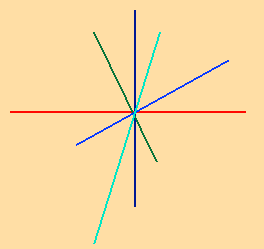Introducing the Pinpoint Theory in the Bible Codes
..
..
The purpose of this article is to illustrate a coding procedure known as PinPoint.
A matrix and report are included as an example. The subject of the matrix is, The 70 AD Siege of Jerusalem. This was selected because it is not controversial, and there exists dates, names, and what can be reasonably construed to be accurate accounts of the siege (as recounted by Josephus). There are those who believe that Josephus' account cannot be trusted. Since he was an eyewitness to the events, I assert that the basic dates, players, and occurrences CAN be trusted. A lot of my codes research is "end of days" related. I elected to shy away from this subject in presenting the pinpoint article, as it is too controversial and too hard to verify with hard facts.
I believed that Pinpoint worked on historical events because of what I had witnessed in the codes; although I had never really spent any time working along those lines. I had "the Works of Josephus" in my library, and started on that as a reference for historical facts. I had read about the 70 AD siege before and remembered that it was illustrated with amazing detail.
The precepts of PinPoint are easily conveyed. But the ramifications of this coding concept are quite encompassing. Before getting to the subject, I will outline the general parameters that I will attempt to abide by, and explain the reasoning behind them.
It is to my advantage to be as brief as possible as this will eliminate future statements (from me) such as, "Yes, but at that time I was working under an assumption that was later found faulty . . . ." or, "Yes, but at that time we didn't have 3D display" etc, etc. And I behoove the reader to bear in mind that at this point in the codes -- ALL coding methods should be considered experimental. Having said that, I will offer up my own criticism of this approach, but will in no way attempt to be thorough in that regard.
I also recognize that PinPoint may not be applicable to all coding "domains" or to some types of coding that have illustrated traits particular to that situation, domain, information sought, or particular coding method. (webmaster note: this must be Walter's legal statement as written by his lawyer).
As a preface I also need to address some current trends and some problems associated with these trends that the PinPoint precept has a bearing upon.
a. One trend that I see is the fascination with longer ELS terms. This, of course, illustrates the need to snoop. (webmaster note: snooping is finding a term in your matrix and then looking at the letters both before and after the term, to see if it forms a phrase or sentence).
b. Another trend is the acceptance of the idea that long ELS terms are much more common than previously assumed. The acceptance of this idea, and the discovery of more and more long ELSs, have manufactured another problem -- how to relate these long ELSs to one another. The relationship of long ELSs IS what PinPoint PINPOINTS.
c. PinPoint ignores just about all the "rules" of coding: Gone are precepts related to: the theme term, near minimality, conventional measures of proximity, conventional notions concerning row split, and conventional tools that are used to gauge significance. I say "conventional" because "the Doc" (Dr. Robert Haralick) already has software that he believes is applicable for at least a variation of PinPoint. Having said that, I need to note that the Doc's gadget would not be applicable to my system for a number of reasons (too many to list).
Briefly stated, this is the PinPoint concept:
1. My model uses a Maximum Skip, Wrapped Torah (the ITCS calls this a "Rounded Torus"), but the system can be applied in standard searches and in any part of the OT. (webmaster: a toroidal text is one where the beginning is connected to the end of the text; a circle. In conventional codes searches the text is a line length where the line is so many letters long, i.e. 304,805 letters in the Torah).
2. This model makes the assumption that the Torah is "defect free. This "defect free" assumption is mandatory if one is to entertain the "Single Matrix Concept" which will be explained later.
3. Conventional notions concerning the "Main Term" are irrelevant as any ELS term in a PinPoint array can function as the "Main Vertical Term--" i.e., the first term searched in CodeFinder. I mention CodeFinder software specifically as it is the only software (that I know of) that can operate under the PinPoint parameters.
4. In effect, a passage in the bible serves as the "Theme (Main) Term. The ELS terms are elaborations of this PinPoint Passage.
5. Conventional notions concerning proximity do not apply to PinPoint. Instead, the entire Search Area of the Wrapped Torah is considered as a Single Matrix (Single Matrix Concept).
6. Proximity defined: The only terms that can be included are those ELSs that pass through the "Theme Passage" (PinPoint Passage) and share a letter with it. Therefore, acceptable proximity is in no way related to matrix size.
7. These terms (from 5) cannot be included unless they have a less than even odds of appearing ANYWHERE in a Wrapped Torah Search (Single Matrix Concept). i.e., odds less than 1 in 1, or, as is illustrated in CodeFinder software, a positive Search Area R-Value when CodeFinder is set for a "Wrapped Torah Search" (Open "Torah." Settings: check "Let Search Wrap.") Or, if the operator does not believe in wrapped coding, he could do a standard search and leave "Let Search Wrap" unchecked.
8. No term can be included that cannot stand by itself as a thought (a conveyed message, with verb clause or verbless clause).
9. Each ELS must be topically related to each other and to the surface text (PinPoint Passage).

Take a look at the matrix and matrix report on the next page. You can see where the ELS terms share letters with the PinPoint passage. You will also notice that there are 11 ELS terms in the report but only 9 show up in the matrix. I call these "Shared Letter Topically Related" terms. By observation, I have noted that these terms offer up sub-topics within the general topic of the array. In the report they are identified as SLTR, "Shared Letter Topically Related," and the term that it relates to is given.
..
|

